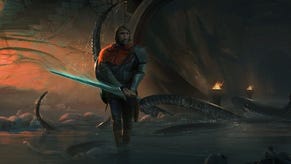Underworld Ascendant Wants Players to Experiment in the Stygian Abyss
Mike takes a look at the successor to the Ultima Underworld series.
This article first appeared on USgamer, a partner publication of VG247. Some content, such as this article, has been migrated to VG247 for posterity after USgamer's closure - but it has not been edited or further vetted by the VG247 team.
Way back in 1992, the developer that would eventually become Looking Glass Studios launched Ultima Underworld: The Stygian Abyss. It was one of the first games to allow players to explore a three-dimensional environment, but that wasn't its only contribution to games. Ultima Underworld was less of a straight up roleplaying game and more of a rich, complex simulation of a dungeon. It was non-linear and almost entirely freeform: players could go where they wanted, kill any non-player character, and solve objectives in a variety of ways.
Ultima Underworld was the grandfather of the immersive sim genre, establishing ideas and concepts that would later appear in The Elder Scrolls series, Deus Ex, and Bioshock, as well as Looking Glass Studios' own System Shock and Thief titles. It's a keystone of gaming as a whole.
Now, some of the folks involved in the original Ultima Underworld are bringing those ideas back to the forefront. Ultima Underworld producer Warren Spector and designer Paul Neurath have landed together at Otherside Entertainment, a studio founded by Neurath in 2013. Together with a team that includes Ultima Underworld II designer Tim Stellmach, Bioshock Infinite writer Joe Fielder, and The Last of Us Lead Artist Nate Wells, Otherside is recreating Ultima Underworld's Stygian Abyss. Underworld Ascendant can't use the Ultima name, but everything else—the world, the characters, and focus on emergent play—that's all coming back.
Underworld Ascendant writer Joe Fielder is showing me through an early build of the game and I can already feel the haunting darkness of the Stygian Abyss. Underworld Ascendant is a sequel to Ultima Underworld, but it picks and chooses from other immersive sims that have come since. It also contains a few hooks from previous Ultima Underworld games.
"If you haven't played the earlier games, you can enjoy it without any worry. I'm a continuity nerd, I like to try and get in as many hooks as possible," says Fielder. "They will be some ties into the original game, and there may be some into the second as well."
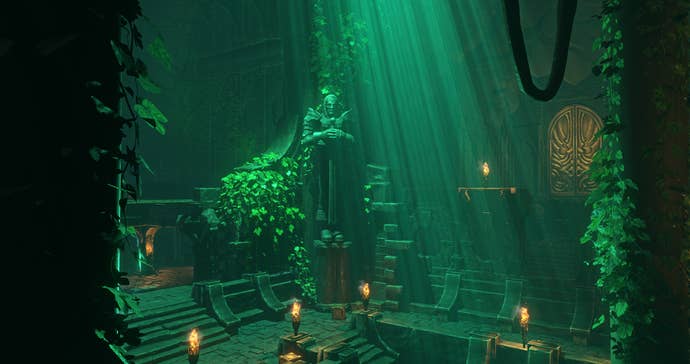
The demo begins in the settlement of Marcaul, where Fielder picks up a quest from one of the three factions in the fighting for control of the underworld: Dark Elves, Dwarves, and Shamblers. There is also a demo-only area here where you could choose between different builds focused on combat, magic, and stealth. Here, shades of the original Deus Ex appear, as the skills in these builds are very granular. They include skills like Jump, Parry, Sprint, Lift, Wall Run, Wall Jump, Stealth Step, Sniping, and Mage Sight.
On top of that, the equipment seems equally varied, starting with basic fantasy weapons and armor, and expanding out to things like tripwires and a host of magical wands. There's a basic fire wand, but also more esoteric options like a Slow Time Wand, a Gravitate Wand, or the very specific Harm Wood Wand. Together with the various skills, the equipment combines to define the framework around your build, which you need to tailor to your playstyle. Thief fans will also be happy to know that torch-killing Soaker Arrows are already in Underworld Ascendant.
Underworld Ascendant is a game that wants players to experiment and explore. As such, the Silver Seed for Ultima Underworld returns. When you plant the seed, it creates the Silver Sapling, which is a resurrection point. If you die, you jump back to where you previously planted the sapling. This allows you to drop the Sapling prior to each new area so you can die a few times to feel things out. There are constraints, like you can't place it on the side of a wall or structure, but otherwise, go wild. (Old Ultima Underworld players used to throw the seed into an unreachable area and then kill themselves.)
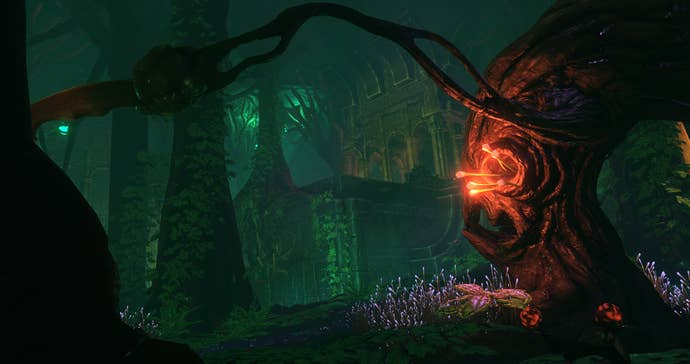
In one entryway, Fielder points out that if there was a door, the simulation allows players to tackle that door in any manner. Lockpick it, use that Harm Wood Wand, or just simply light it on fire. The fire will destroy the door, but might also spread to other objects or characters. You can even take your sword to the door and just bash it in, though it might take you a while.
"All the doors in our game can be beaten down or chopped down with enough time, but I might attract some undue attention," says Fielder.
The area we're exploring in Underworld Ascendant an ancient one, full of ruins covered by twisting vines and glowing alien plant life. Torches light up the darkness, but they're also helped by the faint greenish glow that passes for sunlight down here. Rippers, living trees with swords for branches grow around the area; if you're not quiet and careful, they spring to life, destroying everything nearby. The Ripper's fruit is useful, as Deep Slugs eat it. Deep Slugs secrete trails of oil that can be burned, so if you throw some Ripper Fruit around, you can herd them in different directions and use them to literally light your way.
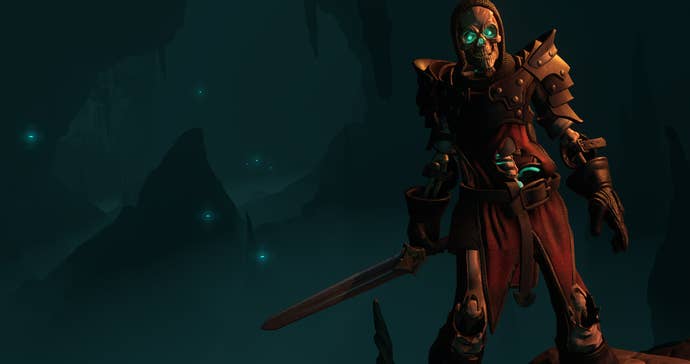
Another non-murder tree produces Glue Bulbs. These can be picked up and thrown anywhere. Once you've placed them, you can attach objects to create new platforms, set up traps, or enact any weird plans you can come up with. Fielder throws a Glue Bulb high into a wall to show me how they work, but his current build lacks the Lift ability, so he can't throw the heavy box any meaningful distance; objects have a listed weight when you pick them up, so if you're going to be throwing things around you need to have the right skills. Alternatively, you can just pick those items up with a Gravitate Wand.
"One of the key things within the game is we want you to be able to experiment. We give you all these options and the solution is up to you. The game is keeping track of everything you're doing and we reward you for creativity. That's tied into the narrative of the game. The difficulty comes from you pushing your own creativity. If you wonder, 'Hey, can I do that?' the answer is 'Yeah, you can.'"
Fielder steps up to a trap, a spinning column with a wicked scythe attached. He shows me one way to get past it that was recently found by one of the game's testers. By throwing a Glue Bulb on the right spot of the blade, it gets caught on the wall, preventing the trap from moving anymore. Sure, you could just gauge the timing and walk past the trap, but getting clever takes it out of play completely. (You could also drop a heavy object in front of the trap.)

Underworld Ascendant, even in this early stage, is full of options like this. Lure undead enemies towards a Ripper and bind them near its whirling blades. Use a Gravitate Wand to levitate a set of makeshift platforms to cross a gap. Succeeding with these various options unlocks Feats. Feats are how you level in Underworld Ascendant instead of killing scores of enemies. Finding unique solutions to problems gives you a Feat, which then unlocks skill points. The developers are playing through their own game and coming up with newer, weirder ways to play each time, which determines which Feats are in-game. As more people play Underworld Ascendant, the list of Feats grows.
The world is also changing and getting a bit worse as you play. Creatures from the lower levels are always slowly making their way upwards as the primordial nightmare Typhon slowly wakes up. You may clear an area only to see more deadly creatures later on. Or perhaps your own allies will occupy the space. There's also a little bit of "design-created variety", according to Fielder; it's not procedural generation, but occasionally there will be different paths and structures in the world.
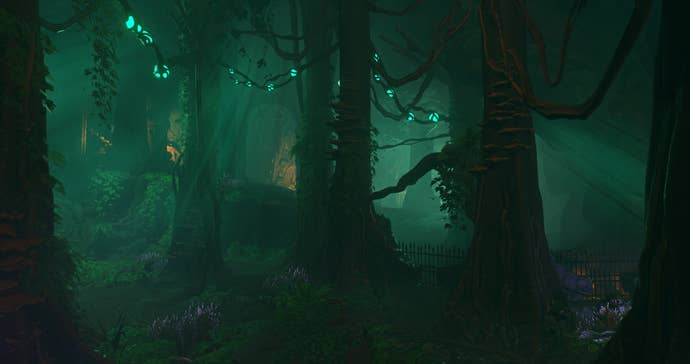
Underworld Ascendant is trying to take the core concepts of Ultima Underworld as a starting point, but ultimately, it's about the original creators of the immersive sim looking back on what they've done in the past and what has come since. It's an attempt to bring all that together to make something new. Underworld Ascendant feels like a boiling cauldron of a number of games I really love, including Thief, Dishonored, Deus Ex, and Skyrim. Hopefully, Otherside Entertainment can deliver, because if they do, this game will be something special.
Underworld Ascendant is planned for launch on PC, Mac, and Linux some time in 2018.



